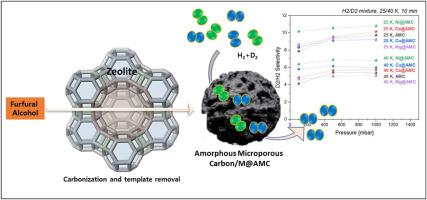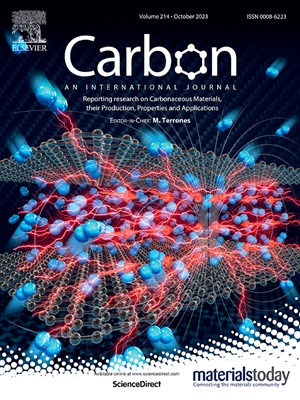用于同位素分离的金属掺杂无定形微孔碳:孔径调节和选择性氘吸附
IF 10.5
2区 材料科学
Q1 CHEMISTRY, PHYSICAL
引用次数: 0
摘要
高效的氢同位素分离对于能源生产和先进科学研究中的应用至关重要,但分离氢同位素却面临巨大挑战。在这项研究中,我们开发了源自沸石模板的无定形微孔碳(AMC),并利用量子筛分技术探索了氢同位素分离。热解吸光谱(TDS)技术用于评估氢(H2)和氘(D2)同位素分离的选择性。在多孔碳中掺入 Ca2⁺、Mg2⁺、Ni2⁺ 和 Cu2⁺等金属离子可调节孔隙的物理化学性质。密度泛函理论(DFT)计算推断,通过掺杂金属调节孔隙增强了材料与 D2 的结合亲和力,从而提高了与原始碳样品相比的分离选择性。这种方法不仅提高了分离效率,还为工业应用提供了一种可扩展且具有成本效益的解决方案。本文章由计算机程序翻译,如有差异,请以英文原文为准。

Metal-doped amorphous microporous carbon for isotope separation: Pore size modulation and selective deuterium adsorption
Efficient hydrogen isotope separation is crucial for applications in energy production and advanced scientific research, but separation of these poses significant challenges. In this study, we developed amorphous microporous carbon (AMC) derived from a zeolite template and explored hydrogen isotope separation using quantum sieving. Thermal desorption spectroscopy (TDS) technique was used to evaluate the selectivity of hydrogen (H2) and deuterium (D2) isotope separation. The doping of metal ions, such as Ca2⁺, Mg2⁺, Ni2⁺, and Cu2⁺, in the porous carbon modulates the physicochemical properties of the pores. The metal-doped carbon samples demonstrated D2 vs H2 selectivity (SD2/H2) of over 10, compared to the pristine carbon's SD2/H2 of less than 8. Density functional theory (DFT) calculation infers that pore modulation through metal doping enhanced the binding affinity of materials towards D2 resulting in increased separation selectivity compared to pristine carbon samples. This approach not only boosts separation efficiency but also provides a scalable and cost-effective solution for industrial applications.
求助全文
通过发布文献求助,成功后即可免费获取论文全文。
去求助
来源期刊

Carbon
工程技术-材料科学:综合
CiteScore
20.80
自引率
7.30%
发文量
0
审稿时长
23 days
期刊介绍:
The journal Carbon is an international multidisciplinary forum for communicating scientific advances in the field of carbon materials. It reports new findings related to the formation, structure, properties, behaviors, and technological applications of carbons. Carbons are a broad class of ordered or disordered solid phases composed primarily of elemental carbon, including but not limited to carbon black, carbon fibers and filaments, carbon nanotubes, diamond and diamond-like carbon, fullerenes, glassy carbon, graphite, graphene, graphene-oxide, porous carbons, pyrolytic carbon, and other sp2 and non-sp2 hybridized carbon systems. Carbon is the companion title to the open access journal Carbon Trends. Relevant application areas for carbon materials include biology and medicine, catalysis, electronic, optoelectronic, spintronic, high-frequency, and photonic devices, energy storage and conversion systems, environmental applications and water treatment, smart materials and systems, and structural and thermal applications.
 求助内容:
求助内容: 应助结果提醒方式:
应助结果提醒方式:


